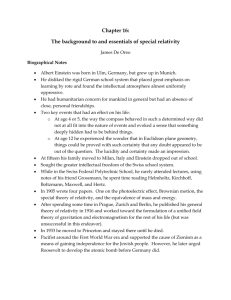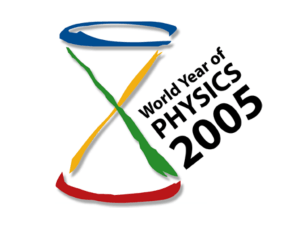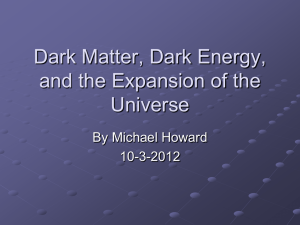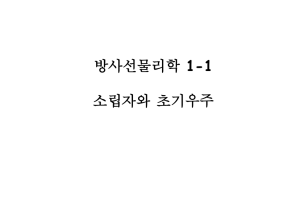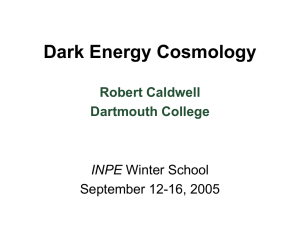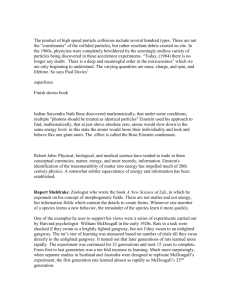Physics 114 Fall 2011
advertisement
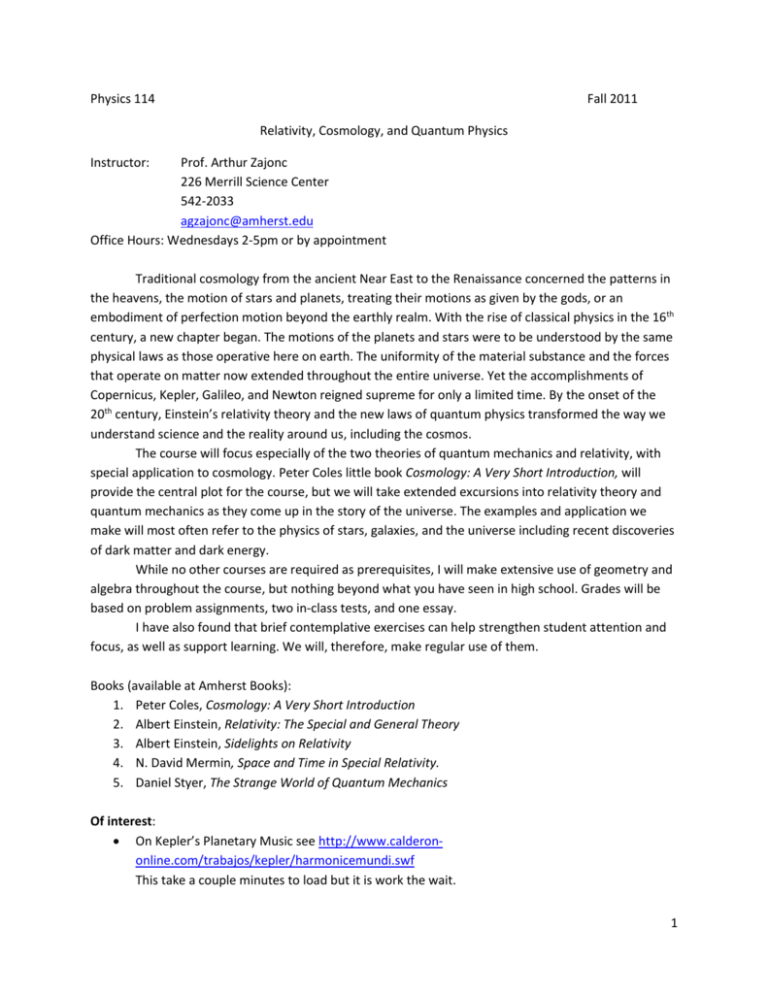
Physics 114 Fall 2011 Relativity, Cosmology, and Quantum Physics Instructor: Prof. Arthur Zajonc 226 Merrill Science Center 542-2033 agzajonc@amherst.edu Office Hours: Wednesdays 2-5pm or by appointment Traditional cosmology from the ancient Near East to the Renaissance concerned the patterns in the heavens, the motion of stars and planets, treating their motions as given by the gods, or an embodiment of perfection motion beyond the earthly realm. With the rise of classical physics in the 16th century, a new chapter began. The motions of the planets and stars were to be understood by the same physical laws as those operative here on earth. The uniformity of the material substance and the forces that operate on matter now extended throughout the entire universe. Yet the accomplishments of Copernicus, Kepler, Galileo, and Newton reigned supreme for only a limited time. By the onset of the 20th century, Einstein’s relativity theory and the new laws of quantum physics transformed the way we understand science and the reality around us, including the cosmos. The course will focus especially of the two theories of quantum mechanics and relativity, with special application to cosmology. Peter Coles little book Cosmology: A Very Short Introduction, will provide the central plot for the course, but we will take extended excursions into relativity theory and quantum mechanics as they come up in the story of the universe. The examples and application we make will most often refer to the physics of stars, galaxies, and the universe including recent discoveries of dark matter and dark energy. While no other courses are required as prerequisites, I will make extensive use of geometry and algebra throughout the course, but nothing beyond what you have seen in high school. Grades will be based on problem assignments, two in-class tests, and one essay. I have also found that brief contemplative exercises can help strengthen student attention and focus, as well as support learning. We will, therefore, make regular use of them. Books (available at Amherst Books): 1. Peter Coles, Cosmology: A Very Short Introduction 2. Albert Einstein, Relativity: The Special and General Theory 3. Albert Einstein, Sidelights on Relativity 4. N. David Mermin, Space and Time in Special Relativity. 5. Daniel Styer, The Strange World of Quantum Mechanics Of interest: On Kepler’s Planetary Music see http://www.calderononline.com/trabajos/kepler/harmonicemundi.swf This take a couple minutes to load but it is work the wait. 1 If you get hooked on the missing 96% of the universe, read The 4% Universe: Dark Matter, Dark Energy, and the Race to Discover the Rest of Reality, by Richard Panek. The First Three Minutes by Steven Weinberg Inflationary Universe, Alan Guth Syllabus (changes likely) Sept. 6 & 8 Overview and Retrospect The Cosmos: Babylonian myth, Greek geometry, Nicolaus Copernicus, Johannes Kepler Reading: Coles, Chapter 1 Sept. 13 & 15 Galileo Universe and Newton’s Dynamics: The concepts of space, time, mass and gravity according to Newton and Einstein. Electromagnetic and gravitational waves. Reading: Coles, Chapter 2 I suggest that you watch a 20 min video on LIGO: http://www.nsf.gov/news/mmg/mmg_disp.cfm?med_id=58443&from=vid.htm Sept. 20 & 22 Light from the cosmos: Light, its spectra, their origins, and what we can learn through spectra about stellar physics and cosmology. Standard candles and supernovae. Reading: Coles, Chapter 3, 4, 5 Sept. 27 & 29 Rotation of Galaxies and Dark Matter. Hubble Law and the expanding universe. Redshifts: Doppler, relativistic, gravitational, cosmological. Readings: Coles, Chapter 6, 7, 8 Einstein Part 1, sections 1-6 October 4 & 6 The concepts of space, time, and the speed of light. Einstein’s two postulates and the relativity of simultaneity. Reading: Einstein: Part 1, sections 7- 10 Mermin: Ch. 2 – 5 2 I will be traveling on October 6th, but I would like to ask that you listen to the Fermi Lab lecture by Prof. Alexei Filippenko of UC Berkeley on “Dark Energy and the Runaway Universe.” It is a fabulous public talk, given at Fermilab on May 20, 2011 by one of those who discovered the accelerating expansion of the universe by studying Type 1a supernovae. You will find it at the address below (fool around with the controls, for example swap the video and slide, or zoom on video or slide, to get the display you like.) http://vmsstreamer1.fnal.gov/Lectures/LectureSeries/110520Filippenko/index.htm# October 13 The Lorentz Transformation, time intervals (time dilation), spatial distances (length contraction) Reading: Oct. 20 & 22 Light as the limit velocity. The Clock “paradox”. E = mc2 . The geometry of space-time Readings: Oct. 4 & 6 Einstein: sections 11- 16 Mermin: Ch. 6-13 Einstein: Ch 17 Mermin: Ch. 14-17 The General Theory of Relativity. Gravitation The equivalence principle. Einstein Ch. 18-20 Mermin: Ch. 18-19 Oct. 13 Bending of light. From Eddington to gravitational lensing. (Oct 11 is break) Einstein Ch. 21-22 Handout Oct 18 & 20 The cosmos according to Einstein. Inflation, the Big Bang and all that Reading: Oct 25 & 27 Introduction to quantum mechanics. History and foundations Reading: Nov. 1 & 3 Styer, Appendices A and B, Ch 1-3 Measurement, probability and Einstein, Podolsky and Rosen Reading: Nov. 8 & 10 Einstein, Ch. 30-32 Handout Styer, Chapters 4-7 Quantum interference 3 Reading: Nov. 15 & 17 Quantum applications: cryptography and computation Reading: Nov. 22 & 24 Styer, Chapters 8-12 Styer, Ch 13 and handout Thanksgiving break Nov. 29 & Dec. 1 The quantum vacuum and the inflationary model of the universe. Reading: Selected chapters of Alan Guth’s, Inflationary Universe Dec 6 & 8 & 13 Special topics as time and interest permit 4
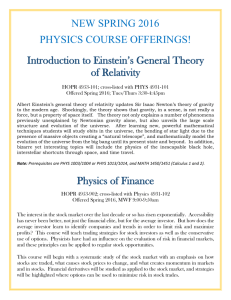
![[Music] HOST: Light, we all know it travels at well, the speed of light](http://s3.studylib.net/store/data/006705142_1-3fb8007e191cfa1d816e02b379710dc2-300x300.png)
